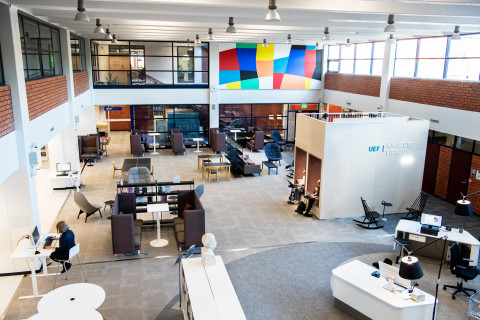Campus development at the University of Eastern Finland identifies, evaluates and outlines the university’s future ways of working and learning, as well as solutions related to technology and facilities, up until 2035. Different visions of the future in campus development have been outlined in the course of scenario work, the final report of which was presented to the academic community by the university’s leadership in a webinar on 6 June.
In the scenario work, alternative, potential and logical descriptions of the university’s future operating environments have been identified. Of the three scenarios presented in the final report, the first one is moderate and follows the current lines of development. The second scenario is based on virtual environments, where most of the academic community’s studying and working takes place more virtually than today. The third scenario is based on a sense of community and on the presence of the university’s partners on campus.
“The scenarios are about mapping different alternatives, and the reality can eventually be a combination of different scenarios. The aim is a dynamic, inclusive, participatory and stimulating campus environment. We may well be seeing more external actors on our campuses, such as public and third sector organisations, as well as companies,” says the university’s Director of Administration Tuomo Meriläinen.
The current use of the University of Eastern Finland’s campus facilities is illustrated by a change in the facility usage rates in 2019, 2021 and 2022. In 2019, the usage rate of all campus facilities was 63%, falling to 29% in 2021, which was characterised by the COVID-19 pandemic, and going up to 48% this year. As the facility costs are rising, campus development is a tool for finding sensible ways to use the facilities and to manage cost growth.
“The past spring semester witnessed a return from the pandemic to a more traditional use of the teaching and research facilities, but not entirely to the same situation as before the pandemic. This tells us that we need to look at the future of our campus facilities in a new way. There may also be new kind of facility needs, such as more facilities where students can work in groups, which are already now in high demand. We need to pay attention to the modifiability of our facilities, and the perspectives of community spirit and well-being must also be considered. Our students must have opportunities for making friends and forging professional contacts on campus,” Meriläinen says.
This spring, the ways of working and facility needs of the university’s units were investigated in a survey aimed at the heads of departments and schools. According to Director of Learning Environment Development Kari Korhonen, the results of the survey illustrate the effects of the COVID-19 pandemic, i.e., a decrease in in-person teaching and an increase in online and blended learning.
“Large auditoriums will be needed also in the future, but not to the same extent as before. We need more facilities for independent study and working in groups, and this may also mean increasingly diverse services on campus,” Korhonen says.
Rector Jukka Mönkkönen points out that internationalisation, responsibility and digitalisation, among other things, have been shaping the university’s external and internal environment already before the pandemic; however, the pandemic has accelerated the change.
“Multidisciplinarity, multi-professionalism and collaborative teaching require increased interaction and knowledge sharing. Our ways of doing things are changing, and our working environments must support that transformation. The COVID-19 pandemic has shown how quickly the world can change. The need for traditional, large offices is changing and decreasing. Research environments will continue to be a major, important entity for the university,” says Mönkkönen.
The work on campus development will continue with the formulation of objectives and policies. In the autumn, a designer will be selected for the campus development work, and the synergy review process will proceed as inclusive collaborative development, including site visits, workshops and testing of the designs. It is hoped that the discussion will continue locally within work communities and together with the heads of departments and schools.
“The campus development project as a whole will be carried out in an inclusive manner. Facility users will play a key role in development and decision-making. Here at the University of Eastern Finland, we have a lot of experience and know-how in the development of learning environments, and we will also be making use of this strong expertise,” says Academic Rector Tapio Määttä.





